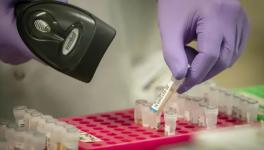COVID-19: Virus Strain Dominant Worldwide Is Different from Original in Wuhan

Image Source: Cell.
Viral evolution is a common phenomenon. Among other factors that marks how a virus evolves is what is known as point mutation. A point mutation can either be in a specific location of the DNA or it can give rise to the change in a specific position of a critical viral protein. A change of a single base in the DNA or a single amino acid of a protein, the hallmark of point mutation can bring in huge change in terms of physiology, infectivity, severity of a microorganism, and for that matter, in any organism. As a result of such point mutations, different strains of a virus are evolved, that is slightly different version of the original virus.
SARS-CoV-2, the coronavirus that caused the COVID-19 pandemic with devastating consequences, also has undergone such point mutation and hence different strains have emerged. A Cell publication has found out the viral strain that possibly emerged during April 2020 and now has become the dominant viral form worldwide. The strain named as D614G is different from the original one found in Wuhan, China and is more infectious. But, the good thing is this strain is not associated with disease severity. The original strain was D614 and the mutated and most prevalent one is G614. The change, apparently, is in the spike protein which is crucial in helping the virus enter the host cell.
Importantly, it has also been found that the G614 variant is dominant in varied geographical locations—city, country, sub country. Bette Korber, a theoretical biologist at Los Alamos National Laboratory and lead author of the study, said, "The D614G variant first came to our attention in early April, as we had observed a strikingly repetitive pattern. All over the world, even when local epidemics had many cases of the original form circulating, soon after the D614G variant was introduced into a region it became the prevalent form."
The change in the amino acid sequence and the global prevalence was found through the adoption of a bioinformatics (computational) approach. But the severity and infectivity are found in experiments involving cell culture.
The experiments in the study say that the G614 strain is more infectious and the viral loads are also found to be higher than the original D strain. Nevertheless, this does not give rise to disease severity, the study concludes.
“The clinical data in this paper from Sheffield showed that even though patients with the new G virus carried more copies of the virus than patients infected with D, there wasn't a corresponding increase in the severity of illness”—said E.O Saphire, co-author of the study and also the person who leads the Coronavirus Immunotherapy Consortium.
The researchers could track the global prevalence of strains of the novel coronavirus only because scientists worldwide are publishing the sequence data of the virus with an unprecedented speed. Many countries have done the viral sequences and in different time during the course of the disease in their place. This is remarkable in scientific research. The fist sequence was published by China way back in January, just at the beginning of the pandemic. Since then the process is ongoing with a great speed.
The sequence data used in the study was taken mainly from the GISAID database. GISAID is a global initiative that works as a primary source of genomic data for influenza viruses. It was established in the year 2008. But during the COVID-19 pandemic it has become the main source of sharing viral sequences among researchers.
Get the latest reports & analysis with people's perspective on Protests, movements & deep analytical videos, discussions of the current affairs in your Telegram app. Subscribe to NewsClick's Telegram channel & get Real-Time updates on stories, as they get published on our website.
















